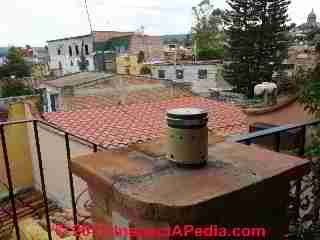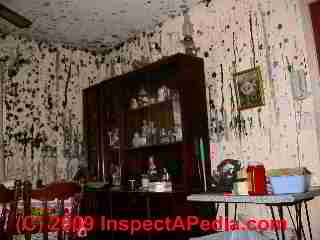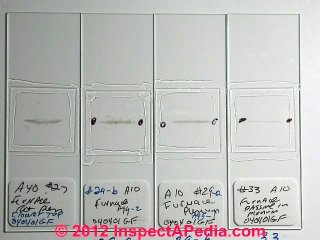 Mold Tests: Spore Count Validity
Mold Tests: Spore Count Validity
- POST a QUESTION or COMMENT about the validity of indoor airborne mold spore counts, causes of count number variation, accuracy questions
Mold spore count validity: this document discusses a serious question about the currently-popular "spore counts" obtained by industrial hygienists, home inspectors, and "mold investigators" (and the mold testing laboratories they use).
Airborne or other mold counts are used to estimate the toxic or allergenic mold exposure level of building occupants in buildings where mold may be present.
InspectAPedia tolerates no conflicts of interest. We have no relationship with advertisers, products, or services discussed at this website.
Accuracy & Validity of Indoor Fungal Spore Counts & Cultures
 First, should we be testing for mold at all? If you see mold on indoor surfaces, NO mold testing is needed just to confirm that mold is present in a this building and that cleanup is needed.
First, should we be testing for mold at all? If you see mold on indoor surfaces, NO mold testing is needed just to confirm that mold is present in a this building and that cleanup is needed.
The clean-up procedures for mold contamination do not depend on the mold genera/species, with the sole exception of cosmetic-molds on some framing lumber.
See also BLACK MOLD, HARMLESS for identification of cosmetic black mold.
Only an idiot, or perhaps someone out to prey on mold fear would require a mold test to determine if the home at left needs professional mold remediation.=
But there may be other reasons to test to identify the dominant mold genera/species in a building.
For example, if a large remediation project is planned, tests may be needed for project control - to be able to prove later that other building mold contamination or moldy dust did or did not come from an improperly-handled mold remediation job.
We also may include tests for airborne mold as a part of a more thorough building investigation and screening for hidden mold contamination, but we would not rely on an air test alone in that case.
Finally, we may want to identify the dominant mold genera/species in a building as an aid to medical diagnosis and treatment. Details about reasons to test for mold and warnings about mistaking a "mold test" for a useful building inspection and diagnosis to find hidden mold or to determine how to prevent future mold contamination are found at
- MOLD TEST REASONS
- MOLD TEST vs. PROBLEM DIAGNOSIS
- MOLD / ENVIRONMENTAL EXPERT, HIRE ? also explains when it is or is not appropriate, justified, and ethical to hire a mold consultant to inspect, diagnose, and advise about mold contamination in a building.
- MYCOPHOBIA, STAINS MISTAKEN for MOLD
Mold Count Precision is Not Mold Exposure Accuracy
 Counting indoor mold spore levels per cubic meter of air or "liter"
produces numbers which may be very precise (many digits or decimal places) but which are generally highly inaccurate (wrong by
one to three orders of magnitude).
Counting indoor mold spore levels per cubic meter of air or "liter"
produces numbers which may be very precise (many digits or decimal places) but which are generally highly inaccurate (wrong by
one to three orders of magnitude).
Enormous variations in the level of airborne particles in buildings occur from even the simplest changes such as walking through a room or turning on a furnace blower.
While many laboratories, including our own, participate in programs to calibrate and standardize their in-laboratory particle counting, slide preparation, and microscopy procedures,
no amount of precision in lab counting can overcome the several orders of magnitude in variation of indoor particle levels that actually occurs in a building over intervals as short as a few seconds and as long as days or months.
While there is a useful place for every environmental investigation tool, inadequacies in field procedure, field condition reporting, and visual inspection that would permit an interpretation of lab results limit the usefulness of "bare lab reports" which simply give a number.
The number may be impressively precise, but highly inaccurate.
Thus airborne mold exposure levels based on single-time-interval use of these tools are unlikely to be accurate.
Spore Counts Obtained by Airborne Mold Spore Traps are of Questionable Accuracy
Warning: interpret all quantitative data, particularly counts of particles in indoor air, with great caution. Individual samples of particles in air show tremendous variation from minute to minute, making "ok" test results a thing to view with skepticism.
Examples of factors which can cause an exponential difference in particle levels in indoor residential air over short time intervals include: mechanical disturbance (walking across a carpet or moving a moldy cardboard box), operation of hot air heating system or central air conditioning system, operation of other building fans, particularly ceiling fans and vacuum cleaners, turning lights on and off, and opening or closing windows and doors. In situations of particular risk, additional or periodic testing should be considered.
Also see ACCURACY vs PRECISION of MEASUREMENTS where we argue that measurements should be reported to include their percentage of error or a +/- figure to give a realistic understanding of the actual reliability of the data.
Indoor counts vs. outdoor counts
The University of Minnesota fungal experts observe that an outdoor-baseline comparison to indoor air is not valid when the outdoor sample was taken during or immediately after precipitation (spore counts plummet outdoors in the rain and might soar right after it), and the comparison is probably not valid in winter when outdoor counts tend to be below indoors. We agree and add other constraints: snow cover practically eliminates spores from outdoor air.
Even in warm weather spore counts vary during the day as weather conditions (humidity, temperature, period after rainfall) affect sporulation and spore movement.
Air sampling by culture plate or surface testing by swab are questionable
Similarly, tests which rely on culture to identify particles are at severe risk of giving a "false negative" result, missing a serious problem, or of giving a "misleading positive" result by asserting that a particular spore which grew on the culture is the problem in the building. Fungal spores grow at different rates on different culture media.
Spore "A" may "overgrow" spore "B" in a particular test, obscuring the presence of spore "B" which might be the real problem in the building. Some fungal spores won't grow at all in culture media (non-viable spores and many Ascospores) but may still be present at toxic levels in a building.
More about mold testing and the validity of air sampling and home test kits for mold:
- SWAB SAMPLING PCR MOLD TESTS - what works or does not work about swab sampling for mold
- ARE MOLD TEST KITS USEFUL?
- VALIDITY OF CULTURE METHODS FOR TOXIC MOLD INSPECTIONS and "home test kits"
- VALIDITY OF AIR SAMPLES FOR MOLD and interpretation of findings or reports
- VALIDITY OF BULK SURFACE OR TAPE SAMPLING for mold and interpretation of results
- MOLD INSPECTING, TESTING, OR SAMPLING METHODS IN THE INDOOR ENVIRONMENT - description and critique
As a collector of studies, papers, books on this topic, and as someone conducting our own studies, we have seen a very wide range of opinion among experts in the field.
Spore allergenicity or toxicity varies widely among fungal genera/species. So does the sensitivity of humans and other animals to fungal spores.
Mold Spore Toxicity Variations by Species, Genera, particle size, even growth substrate
So no single number will be absolutely correct. Just as spore toxicity varies by species, so does the physical size of individual spores. The effect of breathing air contaminated by 5000 Penicillium sp. spores per cubic meter is unlikely to be identical to the effect of breathing 5000 Stachybotrys chartarum spores per cubic meter of air.
Not only does their chemistry and toxicity vary, but a typical Pen/Asp spore is about 2 microns in diameter (1/25th the width of a typical human hair) while a typical Stachybotrys chartarum spore might be 8 x 12 microns -- much larger and thus providing more potentially harmful material per individual spore.
Spore Toxicity Variation Precludes Credible Single Number Mold Exposure Standards
You can see that writing federal or state standards for permissible fungal spore exposure by "count" or "levels" is difficult. Not only are there many variables to consider, but using currently popular air sampling or culture methods, even a low or "OK" test result cannot guarantee that there is no problem in the building.
Fortunately one can become reasonably confident about the level of mold or allergen risk in a building through competent visual inspection, judicious use of various sampling tools and methods, and competent laboratory determination work. Because this expertise is costly and the work time consuming, it should not be ordered without reasonable justification.
Readers should see SORTCOMINGS of AIR SAMPLING for MOLD
and also see AIRBORNE PARTICLE COUNT VARIATION EXTENT
and ACCURACY OF AIR TESTS for MOLD - a quick tutorial.
For a more in-depth critique of popular mold testing methods than this tutorial
see MOLD SAMPLING METHODS IN THE INDOOR ENVIRONMENT or select a topic from closely-related articles below, or see our complete ARTICLE INDEX below.
Watch out: changes in air movement velocity or direction can make any indoor air quality test including for airborne mold spores very inaccurate.
See AIR MOVEMENT in BUILDINGS
...
Continue reading at AIRBORNE PARTICLE COUNT VARIATION CAUSES or select a topic from the closely-related articles below, or see the complete ARTICLE INDEX.
Or see these
Recommended Articles
- ACCURACY vs PRECISION of MEASUREMENTS
- ACCURACY OF AIR TESTS for MOLD - home
- ACCURACY of MOLD TESTS - all types of mold tests
- AIRBORNE PARTICLE TEST SAMPLING CASSETTE STUDY
- AIRBORNE MOLD SPORE COUNT GUIDE - home
- AIRBORNE PARTICLE LEVELS vs IAQ - home
- AIRBORNE MOLD COUNT VALIDITY
- AIRBORNE PARTICLE ANALYSIS METHODS
- AIRBORNE PARTICLE COUNT VARIATION CAUSES
- AIRBORNE PARTICLE COUNT VARIATION EXTENT
- AIRBORNE PARTICLE COUNT VARIATION EXTENT
- AIRBORNE PARTICLE COUNTS in DUCTWORK
- AIRBORNE PARTICLE COUNTS vs SAMPLER HEIGHT
- AIRBORNE PARTICLE COUNTS vs WINDOWS, DOORS
- AIRBORNE PARTICLE SIZE TABLE
- FALSE NEGATIVE MOLD TEST RESULTS
- MOLD CULTURE TEST ERRORS
- MOLD CULTURE TEST KIT VALIDITY
- MOLD EXPOSURE RISK LEVELS
- MOLD EXPOSURE STANDARDS - home
- MOLD INVESTIGATION REPORTS
- MOLD LAB REPORTS
- MOLD LEVEL REPORTING
- MOLD TEST PROCEDURES
- MOLD TESTING METHOD VALIDITY
- MOLD TESTING & SAMPLING MISTAKES
- USES of AIRBORNE PARTICLE SAMPLING
- VISUAL INSPECTION & HISTORY of MOLD
Suggested citation for this web page
AIRBORNE MOLD COUNT VALIDITY at InspectApedia.com - online encyclopedia of building & environmental inspection, testing, diagnosis, repair, & problem prevention advice.
Or see this
INDEX to RELATED ARTICLES: ARTICLE INDEX to MOLD CONTAMINATION & REMEDIATION
Or use the SEARCH BOX found below to Ask a Question or Search InspectApedia
Ask a Question or Search InspectApedia
Try the search box just below, or if you prefer, post a question or comment in the Comments box below and we will respond promptly.
Search the InspectApedia website
Note: appearance of your Comment below may be delayed: if your comment contains an image, photograph, web link, or text that looks to the software as if it might be a web link, your posting will appear after it has been approved by a moderator. Apologies for the delay.
Only one image can be added per comment but you can post as many comments, and therefore images, as you like.
You will not receive a notification when a response to your question has been posted.
Please bookmark this page to make it easy for you to check back for our response.
Our Comment Box is provided by Countable Web Productions countable.ca
Citations & References
In addition to any citations in the article above, a full list is available on request.
- In addition to citations & references found in this article, see the research citations given at the end of the related articles found at our suggested
CONTINUE READING or RECOMMENDED ARTICLES.
- Carson, Dunlop & Associates Ltd., 120 Carlton Street Suite 407, Toronto ON M5A 4K2. Tel: (416) 964-9415 1-800-268-7070 Email: info@carsondunlop.com. Alan Carson is a past president of ASHI, the American Society of Home Inspectors.
Thanks to Alan Carson and Bob Dunlop, for permission for InspectAPedia to use text excerpts from The HOME REFERENCE BOOK - the Encyclopedia of Homes and to use illustrations from The ILLUSTRATED HOME .
Carson Dunlop Associates provides extensive home inspection education and report writing material. In gratitude we provide links to tsome Carson Dunlop Associates products and services.

